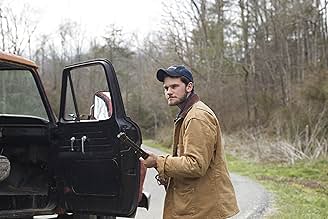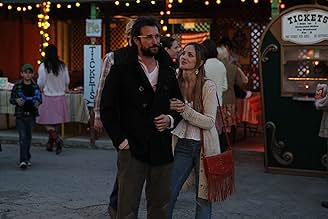Em uma comunidade rural dos Apalaches assombrada pelo legado de um massacre da Guerra Civil, um jovem rebelde luta para escapar da violência que o ligaria ao passado.Em uma comunidade rural dos Apalaches assombrada pelo legado de um massacre da Guerra Civil, um jovem rebelde luta para escapar da violência que o ligaria ao passado.Em uma comunidade rural dos Apalaches assombrada pelo legado de um massacre da Guerra Civil, um jovem rebelde luta para escapar da violência que o ligaria ao passado.
- Mrs. Ponder
- (as Sandra Lafferty)
- Direção
- Roteiristas
- Elenco e equipe completos
- Produção, bilheteria e muito mais no IMDbPro
Enredo
Você sabia?
- CuriosidadesGenerally speaking, in the mountains of western North Carolina, support for the Confederate government was strongest in the towns, while the small farmers, few of whom had ever been slaveholders, were for the old flag. These were subsistence farmers who grew most everything the family used, and had no real means of marketing any surplus produce. They went to town three or four times a year, (usually when court was in session, for the entertainment), to shop or trade for the things they could not grow, like gunpowder, coffee, and salt. Salt was particularly important because this was the only means of preserving meat. By late 1862, Confederate store keepers in Marshall were refusing to sell salt to outlying farmers, whose unionist sympathies were known. This led to a "salt riot" in Marshall when a band of farmers came to town, broke into stores, and took the salt they needed. Around half of the victims of the Shelton Laurel Massacre were known to have participated in this riot. The 64th North Carolina, the regiment that perpetrated the massacre, was composed of many who were raised in Madison County. Colonel Lawrence Allen was from Marshall, and the "salt rioters" broke into his home, where two of Allen's children were sick in bed with scarlet fever. The rioters stole the blankets and sheets from the beds of the sick children, who within a few days were dead. This enraged the men of the 64th, who, being from Madison County themselves, knew how to round up the rioters. The Lieutenant Colonel of the regiment, Keith, led this retaliatory raid into the small valley of the Little Laurel, which is usually called Shelton Laurel, as so many Sheltons lived there from the earliest days of settlement. Part of the regiment circled around through Tennessee to arrive at the top of the valley, while the rest of the regiment came in from the lower end. As this main body penetrated the valley they were fired at several times from ambush. They came to a home, put a noose around the neck of an old woman, tossed the end of the rope over a tree branch, and hoisted her up until her shoe tips were scuffing the dirt, in an effort to make her talk. Eventually the converging pincers of the 64th netted fourteen men, who were kept overnight in a corn crib. The next day they were marched off, purportedly to be taken to Knoxville, Tennessee, the headquarters for the Department, where they were imprisoned. When the prisoners were taken out that morning, one young boy stayed back hiding in the corn crib, so only thirteen departed. A short way on the march, all were shot in the back of the head while kneeling, execution style. The governor of the state, Zeb Vance, was from neighboring Buncombe County, and his first job had been working as a desk clerk at the Hot Springs Hotel. Hot Springs being the other metropolis of Madison County, in addition to being the county seat. Vance was horrified, and sent the NC Attorney General, Augustus Merrimon, who was also a mountaineer, to investigate. Keith was blamed as the moving force behind the events, but was by that time out of the state, in east Tennessee with the 64th NC. After the war, Keith was indicted on thirteen counts of murder, but obtained a change of venue to Buncombe County. Keith was tried only on the first charge, which prosecutors felt was the strongest case, and was swiftly convicted. Keith appealed to the North Carolina Supreme Court, and was incarcerated in the Buncombe County jail to await the result of his appeal and possible hanging. Keith escaped from the jail, and disappeared days before the result was back from the state Supreme Court, which was that the blanket pardon - recently issued by President Andrew Johnson for anything anyone had done while in uniform during the war covered his case - and thus Keith was not liable for prosecution for any of the thirteen murders. Many years later Keith returned to the area, where he circulated a pamphlet in which he claimed he had been living in Mexico, where he had killed a man in a gunfight, instigated by that man's disparaging remarks about southern women. Keith then left again, or at least disappeared, and his ultimate fate is unknown. The widows and orphans of the victims of the massacre made a claim for compensation from the Federal government under postwar legislation, the claim of which was endorsed without comment by Vance - by then back in congress - and also by Merrimon. These claimants tried to stretch things a bit too far, alleging that their homes were burned as they watched their men killed, even though no homes were burned and they did not witness the killings. Central to the claim was the allegation that these murdered men had embodied themselves as a military unit in 1861 with the intention of joining the Union forces. But finding it impossible at that time to cut their way through to join up with a Union army, had returned home. David Shelton would have been nine years old at the time he was alleged to have joined the US Army in 1861. This claim ultimately failed. At least one of the victims of the Massacre, Roderick "Stob Rod" Shelton, had enlisted in the Confederate Army in July, 1861, in the 29th North Carolina, but by a year later had deserted and apparently returned home.
- Citações
[first lines]
Leonard: [narrating] Landscape is destiny. I've carried that phrase in my head for years now. I can't remember where it comes from, but I know what it means here. It's a sense of being closed-in. Human limitation. It's different from the Midwest, where possibility sprawls bright and endless in every direction. People in the Himalayas, the Andes, do they live in the passive voice too, like their live aren't real? Their memories fixed, immutable?
- skinner_douglas
- 14 de jun. de 2015
- Link permanente
Principais escolhas
- How long is The World Made Straight?Fornecido pela Alexa
Detalhes
- Data de lançamento
- País de origem
- Centrais de atendimento oficiais
- Idioma
- Também conhecido como
- The World Made Straight
- Locações de filme
- Empresas de produção
- Consulte mais créditos da empresa na IMDbPro
- Tempo de duração1 hora 59 minutos
- Cor
- Proporção
- 2.35 : 1
Contribua para esta página









































